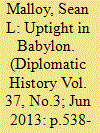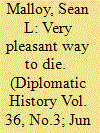|
|
|
Sort Order |
|
|
|
Items / Page
|
|
|
|
|
|
|
| Srl | Item |
| 1 |
ID:
079238


|
|
|
|
|
| Publication |
2007.
|
| Summary/Abstract |
This essay explores the evolution of American nuclear targeting during World War II. Initial discussions in Washington focused on the use of the bomb against a military target. The assumption that cities would be the primary target for the atomic bomb apparently originated at Los Alamos in 1943 - 44, largely as a result of technical concerns related to the delivery and functioning of the weapon. Some high-level officials in Washington voiced reservations about the use of nuclear weapons against primarily civilian targets. Ultimately, the accumulated momentum of previous technical decisions and a desire to use the bomb as quickly as possible for military-diplomatic reasons convinced the President and his advisors to overcome reservations about targeting Japanese cities and civilians
|
|
|
|
|
|
|
|
|
|
|
|
|
|
|
|
| 2 |
ID:
123846


|
|
|
|
|
| Publication |
2013.
|
| Summary/Abstract |
Eldridge Cleaver (1935-1998) was a key figure in the U.S. black power movement in the late sixties and early seventies whose globe-trotting freelance diplomacy on behalf of the Black Panther Party (BPP) led him from Soledad prison to the streets of Oakland, California and from there to Havana, Algiers, Pyongyang, Beijing, Hanoi, Brazzaville, and Paris. Cleaver's party-building efforts with the BPP illustrated the powerful appeal of an anticolonial analysis that looked beyond the East-West dynamics of the Cold War to position people of color as part of a global North-South struggle over decolonization. Cleaver's journey also illustrated the continuing and ultimately tragic relevance of the Cold War to the evolution of the African American freedom struggle. In establishing the International Section of the BPP, Cleaver found himself dependent on the whims of his new allies and highly sensitive to changes in the Cold War environment.
|
|
|
|
|
|
|
|
|
|
|
|
|
|
|
|
| 3 |
ID:
113053


|
|
|
|
|
| Publication |
2012.
|
| Summary/Abstract |
One of the distinguishing characteristics of the atomic bombs used against Hiroshima and Nagasaki was their accompanying radiation effects. The effects of ionizing radiation on the bomb's survivors have been the subject of intense study and discussion since August 1945. This article examines a related question that has received surprisingly little scholarly attention: what did American scientists and policy makers know about radiation effects prior to the use of the bomb? In making the decision, did American leaders understand that the atomic bombs used against Japanese cities and civilians would have lingering and deadly effects in some ways analogous to chemical or biological weapons?
A careful study of pre-Hiroshima knowledge of radiation effects in the United States makes it clear that most of the immediate and long term biological effects of radiation on the victims of the bomb were, in fact, predictable at the time of the A-bomb decision. While the pre-Hiroshima understanding of radiation among Manhattan Project scientists was far from perfect, that the bomb would produce lingering and lethal effects was suggested as early as 1940. Extensive research carried out by Manhattan Project scientists and physicians during World War II, including both human and animal experiments, greatly expanded knowledge of the biological effects of ionizing radiation.
Despite the intense wartime study of radiation effects in the United States, this knowledge played little or no role in the decision to use the atomic bomb. The policy of compartmentalization and secrecy enforced by Manhattan Project director General Leslie R. Groves, combined with the single-minded drive at Los Alamos to build a working bomb, meant that few even inside the Manhattan Project itself were aware of, or interested in, the emerging body of knowledge on radiation effects generated during the war. The high-level American leaders who made the final decisions about the bomb, including President Harry S. Truman, Secretary of State James F. Byrnes, and Secretary of War Henry L. Stimson, were never informed that the weapon would continue to sicken and kill its victims long after use.
For all of the outstanding technical successes of the Manhattan Project, the policy of wartime compartmentalization and postwar denial with respect to radiation effects ultimately served neither American leaders nor the many victims of the bomb in Japan. In addition to analyzing the evidence of pre-Hiroshima knowledge of radiation effects in the United States, this article explores the disconnect between scientific knowledge and political decision making with respect to the atomic bomb that would continue into the Cold War.
|
|
|
|
|
|
|
|
|
|
|
|
|
|
|
|
|
|
|
|
|